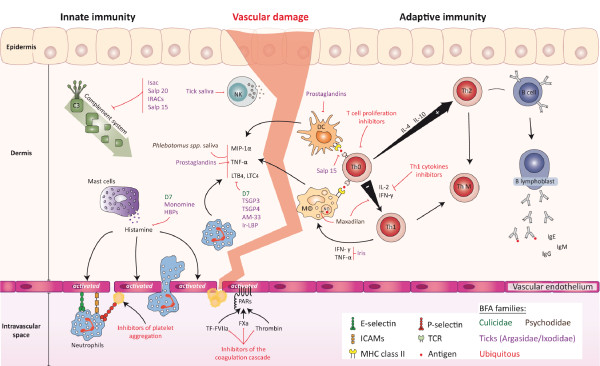Figure 2.
Schematic representation of arthropod salivary proteins involved in the modulation of innate and adaptive immunity. Protective immunity against haematophagous arthropods (HA) involves both innate and adaptive immunity. Cells involved in the innate response (e.g., neutrophils, natural killers cells (NK), mast cells and macrophages (MΦ)) represent the first line of defence. Once activated, these cells release molecules (e.g., macrophage inflammatory proteins -1 α (MIP-1α), tumour necrosis factor- α (TNF- α) or leukotrienes (LB4, LTC4) that initiate the inflammation process. This local inflammation can further be triggered by the activation of complement, which has chemotactic and inflammatory properties. Endothelial cells and platelets can be activated by the binding of factors of the coagulation cascade to PAR receptors, leading to an over-expression of surface adhesive molecules (ICAMs, E-selectin, P-selectin) that participate in neutrophil migration. Antigen presenting cells, such as dendritic cells (DC) migrate to the lymph nodes where they interact with naïve CD4+ helper T lymphocytes (Th0 cells) via the interplay of their T cell receptors (TCR) and major histocompatibility complex (MHC) class II proteins. Th0 cells have the potential to proliferate and to differentiate into two distinct lineages of effectors cells: Th1 and Th2 cells. Memory T helper (Th M) cells, which can improve the quality of the response to a subsequent exposure by developing more efficient memory capacity over time, are also produced. In a general pattern, HA saliva down-regulates the expression of Th1 cytokines (such as IL-2) modulating the adaptive immune response to an antibody mediated Th2 response. The action of saliva or salivary proteins is indicated in the figure as well as their corresponding organism's family. (Salivary protein affiliation to HA families is indicated by colour as represented on the bottom right corner legend).

